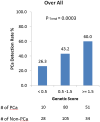Prediction of prostate cancer from prostate biopsy in Chinese men using a genetic score derived from 24 prostate cancer risk-associated SNPs
- PMID: 23868750
- PMCID: PMC3909876
- DOI: 10.1002/pros.22661
Prediction of prostate cancer from prostate biopsy in Chinese men using a genetic score derived from 24 prostate cancer risk-associated SNPs
Abstract
Background: Twenty-four prostate cancer (PCa) risk-associated single nucleotide polymorphisms (SNPs) in Chinese men have been cataloged. We evaluated whether these SNPs can independently predict outcomes of prostate biopsy, and improve the predictive performance of existing clinical variables.
Methods: Three hundred eight consecutive patients that underwent prostate biopsy for detection of PCa at Huashan Hospital, Shanghai, China between April 2011 and August 2012 were recruited. Clinical variables such as serum prostate-specific antigen (PSA) levels and peripheral blood samples were collected prior to a 10-core biopsy. A genetic score based on these 24 PCa associated SNPs was calculated for each individual.
Results: Among 308 patients underwent prostate biopsy, 141 (45.8%) were diagnosed with PCa. Genetic score was significantly higher in patients with PCa (median = 1.30) than without (median = 0.89), P = 3.81 × 10(-6). The difference remained significant after adjusting for age and total PSA, P = 0.007. The PCa detection rate increased with increasing genetic score; 26.3%, 43.2%, and 60.0% for men with lower (<0.5), average (0.5-1.5), and higher (>1.5) genetic score, respectively, P(-trend) = 0.0003. For patients with moderately elevated PSA levels (1.6-20 ng/ml), the PCa detection rate was 31.2% overall and was 16.7%, 31.2%, and 40.9% for men with lower (<0.5), average (0.5-1.5), and higher (>1.5) genetic score, respectively, P(-trend) = 0.03. For patients with PSA ≥ 20 ng/ml, however, the PCa detection rates were high (>69%) regardless of genetic score.
Conclusion: A genetic score based on PCa risk-associated SNPs is an independent predictor of prostate biopsy outcomes in Chinese men and may be helpful to determine the need for prostate biopsy among patients within a "gray zone" of PCa risk.
Keywords: ChinaPCa; PSA; SNPs; risk assessment.
© 2013 Wiley Periodicals, Inc.
Figures




References
-
- Hsing AW, Tsao L, Devesa SS. International trends and patterns of prostate cancer incidence and mortality. Int J Cancer. 2000;85(1):60–67. - PubMed
-
- Ye DW, Li CL, Zhou FJ, Yao XD, Zhang SL, Dai B, Zhang HL, Zhu Y, Shen YJ. Epidemiological trends of prostate cancer: Retrospect and prospect. China Oncology. 2007;17:4.
-
- Moyer VA. Screening for prostate cancer: U.S. Preventive Services Task Force recommendation statement. Ann Intern Med. 2012;157(2):120–134. - PubMed
-
- Sokoll LJ, Chan DW, Mikolajczyk SD, Rittenhouse HG, Evans CL, Linton HJ, Mangold LA, Mohr P, Bartsch G, Klocker H, Horninger W, Partin AW. Proenzyme PSA for the early detection of prostate cancer in the 2.5–4.0 ng/ml total PSA range: Preliminary analysis. Urology. 2003;61:274–276. - PubMed
Publication types
MeSH terms
Substances
Grants and funding
LinkOut - more resources
Full Text Sources
Other Literature Sources
Medical
Research Materials
Miscellaneous

